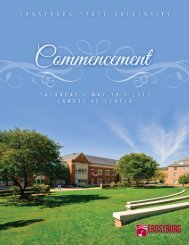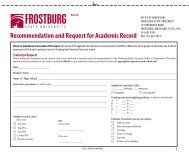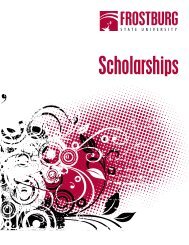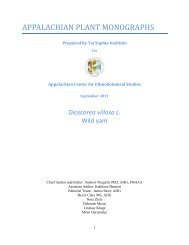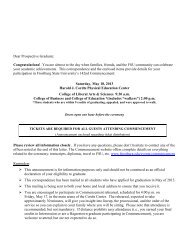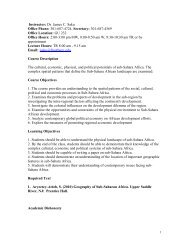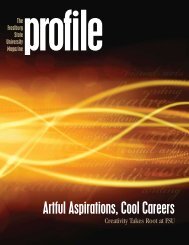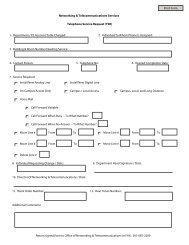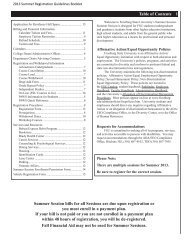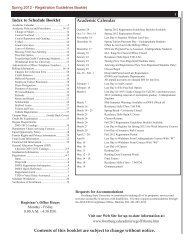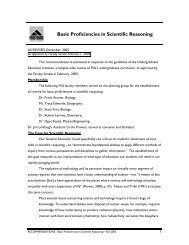Spring 2012 - Frostburg State University
Spring 2012 - Frostburg State University
Spring 2012 - Frostburg State University
Create successful ePaper yourself
Turn your PDF publications into a flip-book with our unique Google optimized e-Paper software.
20<br />
ning, beginning in 2009; FSU was only one<br />
of three recipients of the regional Workplace<br />
Innovation Award based upon CHILL and<br />
its impact upon FSU in 2009. Baer also<br />
presented findings from the first two years<br />
of CHILL in 2010 at the National Wellness<br />
Institution’s National Wellness Conference.<br />
Feedback from this and a regional conference<br />
has further indicated the need for a college<br />
wellness initiative that blends programming<br />
and medical paradigms to promote preventatives<br />
health topics.<br />
In 2011, the National Collegiate Athletic<br />
Association awarded FSU its NCAA Choices<br />
Grant, what will amount to $30,000 over<br />
three years to fund activities, programs and<br />
related materials that will encourage students<br />
to avoid the most dangerous drinking behaviors<br />
– including grain alcohol-based punches<br />
or “jungle juice,” energy drinks laced with<br />
high-proof alcohol and binge-drinking – and<br />
choose low-risk options like beer, or no-risk<br />
options – staying away from alcohol entirely.<br />
The CHILL Choices program has focused<br />
especially on reaching athletes and engaging<br />
all students in attending athletic events,<br />
through programs such as “blackout” games<br />
designed to fill the stands at football, basketball<br />
and other varsity events. Their late-night<br />
three-on-three basketball tournament held<br />
in the fall drew hundreds of students, as well<br />
as some faculty and staff. Not only do these<br />
activities provide some fun for students, they<br />
are a source of input for what opportunities<br />
will resonate with students, and what they<br />
might be doing if those opportunities weren’t<br />
available.<br />
These efforts also dovetail with FSU’s<br />
participation in the National College Health<br />
Improvement Project’s Learning Collaborative<br />
on High-Risk Drinking. FSU has joined with<br />
31 other American colleges and universities<br />
to use scientific evaluation and measurement<br />
techniques to identify and implement the<br />
most effective strategies to address high-risk<br />
drinking. The teams from each institution<br />
Donors Choose to expanD on Chill’s possibilities<br />
While the four years of contributions from AstraZeneca Pharmaceuticals, LLP, have been crucial for getting<br />
CHILL off the ground, CHILL’s efforts have attracted other sources of funding.<br />
The CHILL Choices program, which encourages and educates students, especially athletes, to avoid the most<br />
dangerous drinking behaviors, was made possible through the National Collegiate Athletic Association. The NCAA<br />
awarded FSU what will amount to $30,000 over three years to fund activities, programs and related materials.<br />
Individual donors have also decided to make gifts in support of wellness initiatives. Notable among them<br />
is Col. Donald White ’75, who with his wife established the Colonel Donald J. White and Dr. Janet L. Wasson<br />
Wellness Fund, which supports the FSU Human Performance Laboratory, where research and activities complement<br />
and enhance existing initiatives, and better integrates the efforts in the Department of Health and Physical<br />
Education and the Department of Athletics.<br />
Marion Leonard, professor emerita of FSU’s College of Business, with her husband, also set up the Kim and<br />
Marion Leonard Wellness Outreach Fund. The fund was created to support FSU’s Student and Educational Services<br />
division in developing more programming and activities that empower educators to design learning experiences<br />
that in part encourage students to develop a deeper sense of “mindfulness, authenticity, awareness, vulnerability,<br />
openness, trust, listening and respect,” and to build their emotional intelligence. (For more about this<br />
initiative, see page 13.)<br />
Left: “Teach Me How to Dougie” winners<br />
Above: Fitness guru Scott Cole (left) has<br />
made numerous visits to campus with the<br />
support of CHILL, offering classes in a<br />
variety of exercise styles and encouraging<br />
wellness and healthy activity.<br />
are working with researchers from The<br />
Dartmouth Institute for Health Policy and<br />
Clinical Practice.<br />
“NCHIP allows us to be more intentional<br />
and be more informed in our efforts,”<br />
said Jeff Graham, FSU’s associate dean of<br />
students who is leading the FSU NCHIP<br />
team. Each strategy is tried out and evaluated<br />
quickly through the Plan-Do-Study-<br />
Act model.<br />
“Success in very intentional work is producing<br />
more success,” he said.<br />
what’s next?<br />
A key element of the final year of the<br />
AstraZeneca funding is to show how<br />
CHILL is sustainable and important to the<br />
health of students – looking at their health<br />
in every realm: nutrition, activity, stress<br />
management, socialization and avoiding the<br />
abuse of alcohol and other drugs. Programs<br />
build on other programs, such as NCHIP<br />
and CHILL Choices. Biometric screenings,<br />
and especially the follow-up care that is<br />
offered to those with abnormal results, have<br />
been very effective. Finding resources to<br />
support these programs will be the ongoing<br />
challenge.<br />
“Defining wellness can sometimes be easier<br />
than applying it,” Baer said. “Through<br />
CHILL, we hope to motivate and inspire all<br />
students to take the necessary steps to make<br />
fitness, nutrition and stress management a<br />
priority in their lives.” <br />
living the Chill liFe<br />
A key component of the CHILL program is<br />
embracing a change in lifestyle, especially<br />
coupled with the awareness provided by the cold,<br />
hard facts of biometric screening results. Here<br />
are the stories of two <strong>Frostburg</strong> students who<br />
received a wake-up call as the result of the CHILL<br />
screenings, and the pitfalls and triumphs of how<br />
they answered that challenge.<br />
Frightening symptoms<br />
leaD to Diagnosis anD<br />
liFe Change<br />
In the fall of 2008, Shenna Hair ’11, wasn’t feeling<br />
right. She was experiencing tingling in her feet and<br />
hands and she was urinating frequently. She decided to<br />
check her symptoms on Web MD, and the word “diabetes”<br />
popped up.<br />
“I was eating a bite-sized Reese’s at the time. I<br />
threw it in the trash can right then,” she said.<br />
She went to the Brady Health Center on campus<br />
with her concerns. It so happened that the last CHILL<br />
screening of the semester was the next morning, and<br />
she was urged to take advantage of it.<br />
“It was free, and I didn’t have health insurance.”<br />
Hair’s fasting glucose level came back at 288 mg/<br />
dL, she said. Anything over 126 mg/dL is considered to<br />
be symptomatic of diabetes, according to the American<br />
Diabetes Association.<br />
That’s when the rest of the CHILL program came to<br />
her aid. She immediately got into a follow-up program<br />
through Brady Health, meeting with the nurses and<br />
dietician there to bring her condition under control. In<br />
addition to starting on medication to control her blood<br />
sugar, “I learned about the proper things to eat, counting<br />
carbs, portion sizes, things<br />
like that,” Hair said.<br />
She found support, too,<br />
from friends, her roommate<br />
and two fellow<br />
students who lived across<br />
the hall in their<br />
apartment<br />
Shenna Hair ’11<br />
building. Together they joined CHILL’s “Biggest Loser”<br />
competition, in which teams earn points through documenting<br />
health practices such as keeping workout and<br />
food logs and by participating in wellness education<br />
programs. The competition also gave them access to a<br />
personal trainer, a fellow student in the FSU Health and<br />
Physical Education program, who was able to earn field<br />
work hours at the same time.<br />
She and her friends also cooked healthier food at<br />
home. Because one of those friends was also dealing<br />
with elevated blood pressure, they also watched their<br />
sodium levels as a group. Hair lost 28 pounds over the<br />
course of just over three months, and her later CHILL<br />
screenings came out virtually normal.<br />
“I’m the miracle baby,” she laughed.<br />
Hair knows she needs to keep up her healthy habits,<br />
although she’s finding it more difficult now that she’s<br />
out of school and working an evening shift while she<br />
prepares to go on to graduate school. A chemistry<br />
major at FSU, she had always figured on a career in the<br />
health care industry, but her experience with CHILL and<br />
her own health journey has narrowed that down. Now<br />
she’s applying to master’s programs in public health<br />
and related fields, and hoping to travel to learn about<br />
different health systems.<br />
Regardless of where she ends up, she knows she’ll<br />
need to keep living what she learned about staying<br />
healthy through CHILL.<br />
“This is my life from now on.”<br />
sCreening unearths a<br />
hiDDen Danger<br />
Rachel Clark, a sophomore chemistry major,<br />
thought she was fine. “I’ve never been the smallest<br />
person, but I wasn’t unhealthy.”<br />
But her RA encouraged her to go to a CHILL screening<br />
in the fall of her freshman year. She was curious to<br />
know what she weighed and what her cholesterol was,<br />
plus they were offering free breakfast and a T-shirt.<br />
“I wasn’t doing anything else, so I went.”<br />
The news wasn’t good: “My cholesterol was through<br />
the roof. My bad cholesterol was high, my good cholesterol<br />
was low and my triglycerides were really high,<br />
too,” Clark said. She resolved to do better, but when she<br />
went home for winter break, she found that she had<br />
gained 25 pounds over just her first semester.<br />
She took advantage of being home and started a<br />
program of healthier eating, counting calories and<br />
exercising. She had played basketball in high school<br />
and rode horseback; neither of those activities followed<br />
her to college. Instead, she became a runner.<br />
By the time she returned for spring semester at the<br />
end of January, she had lost 10 pounds.<br />
“I knew it would be harder once I got back to<br />
school,” Clark said. “But I walked down to the caf<br />
(Chesapeake Dining Hall). I didn’t go to Sheetz – that’s<br />
what we would normally do if we didn’t like what they<br />
had at the caf. I’d eat mashed potatoes and broccoli,<br />
get a salad. I didn’t load it up with bacon bits and<br />
heavy dressings. And I stopped eating cake every day.<br />
They had cake there every day!”<br />
She learned to make substitutions, mostly small<br />
ones. Trail mix with dried fruit instead of M&Ms. Wheat<br />
Thins instead of potato chips.<br />
“It got to the point that I didn’t think about it<br />
anymore. I didn’t crave bad food anymore. And I didn’t<br />
gain any more weight,” she said. “Then over the summer<br />
I had more time to exercise. I lost 31 pounds over<br />
the summer.”<br />
When she returned to school in the fall, she was<br />
contacted by Julia Miller, the nurse hired as part of<br />
CHILL to conduct follow-up appointments and counseling<br />
for students with abnormal health screening<br />
results as part of her duties at the Brady Health Center.<br />
Miller encouraged Clark to be rechecked in last fall’s<br />
screening.<br />
“All my numbers were great.”<br />
Rachel Clark<br />
Even as her classes get more challenging, she tries<br />
to figure out ways to keep up an exercise routine and to<br />
avoid backsliding into easy and unhealthy food choices.<br />
Clark has become the one to encourage others to make<br />
healthy choices, urging them to avoid the fried food<br />
that’s still so readily available and inviting them to<br />
come running with her. She’s seen improvements in the<br />
healthy food offerings from ARAMARK at Chesapeake,<br />
but it’s still a matter of making healthy choices.<br />
“They don’t have cake every day now. But they still<br />
have cookies every day.”<br />
She’s also started to get more involved in the activities<br />
that CHILL offers on campus, both for fun and to<br />
help stay focused. She looks around at her fellow students’<br />
unhealthy habits and worries about the state of<br />
their health, knowing from her own experience where<br />
what could have been dangerous cholesterol levels lay<br />
hidden.<br />
“Who knows what would have happened to me if I<br />
didn’t know,” she said. <br />
21




